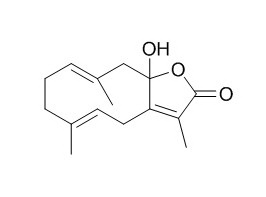Aeruginolactone
Standard reference
Inquire / Order:
manager@chemfaces.com
Technical Inquiries:
service@chemfaces.com
Tel:
+86-27-84237783
Fax:
+86-27-84254680
Address:
1 Building, No. 83, CheCheng Rd., Wuhan Economic and Technological Development Zone, Wuhan, Hubei 430056, PRC
Providing storage is as stated on the product vial and the vial is kept tightly sealed, the product can be stored for up to
24 months(2-8C).
Wherever possible, you should prepare and use solutions on the same day. However, if you need to make up stock solutions in advance, we recommend that you store the solution as aliquots in tightly sealed vials at -20C. Generally, these will be useable for up to two weeks. Before use, and prior to opening the vial we recommend that you allow your product to equilibrate to room temperature for at least 1 hour.
Need more advice on solubility, usage and handling? Please email to: service@chemfaces.com
The packaging of the product may have turned upside down during transportation, resulting in the natural compounds adhering to the neck or cap of the vial. take the vial out of its packaging and gently shake to let the compounds fall to the bottom of the vial. for liquid products, centrifuge at 200-500 RPM to gather the liquid at the bottom of the vial. try to avoid loss or contamination during handling.
Molecules.2021, 26(4):1084.
Anticancer Res.2022, 42(9):4403-4410.
Lab Chip.2018, 18(6):971-978
Mol Biol Rep.2022, doi: 10.1007
Sci Rep. 2017, 12953(7)
Chem Pharm Bull (Tokyo).2017, 65(9):826-832
International Food Research Journal2018, 25(6):2560-2571
Toxicol Rep.2021, 8:1131-1142.
Plant Physiol Biochem.2021, 160:166-174.
Rev. Chim.2020, 71(3),558-564
Related and Featured Products
J Pharm Biomed Anal. 2013 Dec;86:161-8.
Characterization of in vivo and in vitro metabolites of furanodiene in rats by high performance liquid chromatography-electrospray ionization mass spectrometry and nuclear magnetic resonance spectra.[Pubmed:
23998967]
METHODS AND RESULTS:
All of these metabolites were phase I metabolites, with three new compounds including 2β-hydroxyl-Aeruginolactone (2), 14-hydroxyl-Aeruginolactone (3), 1β,8β-dihydroxyeudesm-4,7(11)-dien-8α,12-olide (4a), and four known compounds, 1β,10α,4α,5β-diepoxy-8α-hydroxy-glechoman-8α,12-olide (1), 1β,8β-dihydroxyeudesm-4(14),7(11)-dien-8α,12-olide (4b), 1β,8β-dihydroxyeudesm-3,7(11)-dien-8α,12-olide (5) and Aeruginolactone (6). Interestingly, the metabolite 6 was found to be a primary metabolite in urine, bile and feces. All metabolites were found to be both in urine and bile but only few metabolites except the metabolite 6 presented in feces after oral dose of furanodiene to rats. Furthermore, the metabolic pathways of furanodiene were proposed using an in vitro assay by incubation of furanodiene and its metabolites in vivo with rat liver S9 or liver microsomes.
CONCLUSIONS:
Clearly, Aeruginolactone (6) seemed to be a major precursor for other metabolites.



